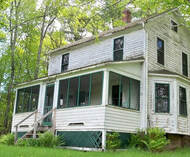I am thinking of buying an old wood frame house constructed in the 1920s. Would there be insulation in the walls?
 1920 Farm House
1920 Farm House This type of design is not only costly with energy bills, but also outside noise will be louder inside. In addition, this design known as "balloon construction," is a serious fire hazard. The walls would act like a chimney in a fire and the wood frame house would be destroyed. Putting insulation into these walls will address all three of these problems: Costly energy bills, Noise levels and Fire hazard.
Is it possible to put insulation in backwards?
Yes, and this happens far too often. Many serious problems come about with insulation installed wrong. In most cases the cause of these problems are a mystery to the homeowner. For example, nobody can imagine why a certain wall gets damp or sweats. The Foil or Paper on one side of the insulation is known as a "vapor barrier" and this "vapor barrier" must always face the warmer side of the house. Always! If there is an outside facing wall that is crying or moisture builds up on the inside surface of that wall, odds state that the insulation was installed backwards. Once confirmed, the inside wall needs to be removed, the compromised moisture filled insulation must be discarded and replaced the correct way.
Insulating the ceiling in my unfinished basement isn't going to save much, right?
This action, in most cases, saves a great deal of money and energy. Put insulation in an unfinished basement ceiling with the "vapor barrier" facing up, because upstairs is the warmer side of the house. However, if you are going to heat or cool your basement, then different rules apply. Also don't let the air from upstairs that has been cooled by air conditioning drop through the floor to your unfinished basement because there is no insulation in the basement ceiling. Cool air dropping into the basement only makes the basement damp and the electric bill higher for the air conditioners working longer on the main floor. "Cold Air drops" that is the rule of mother nature. The other rule mother nature has "Hot Goes To Cold First" then Hot Air Rises! Don't let your heating bills be higher because the heat comes out over a cold floor that is over a cold basement with no insulation in the ceiling. Insulate and save! Reports have shown the savings of several hundred dollars can provide a payback on the cost of insulation and labor as fast as four months.
For more information on insulating houses, see my previous GoingTrueGreen blog called:
Buying A House? Beware!
Bill Lauto, at GoingTrueGreen.com
Environmental Scientist
International Sustainability and Energy Consultant
Contribute your comments!





















